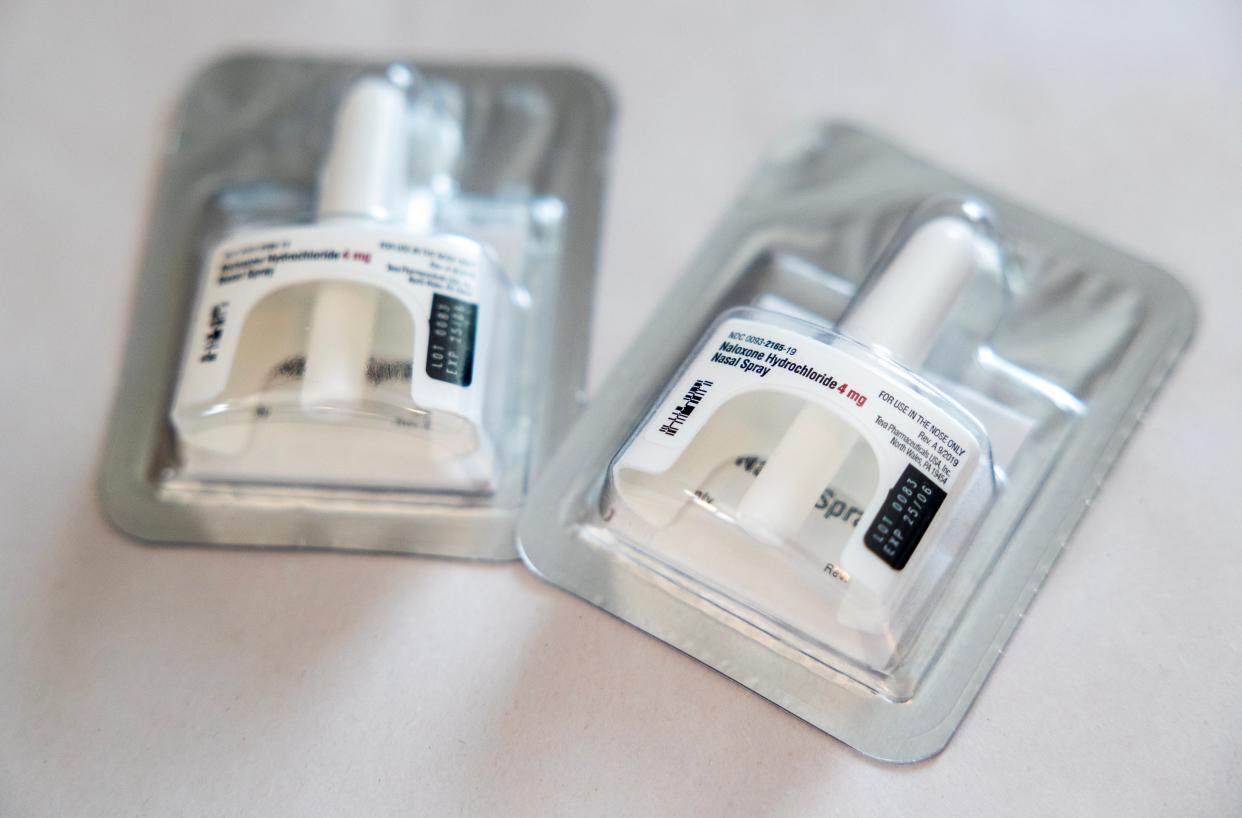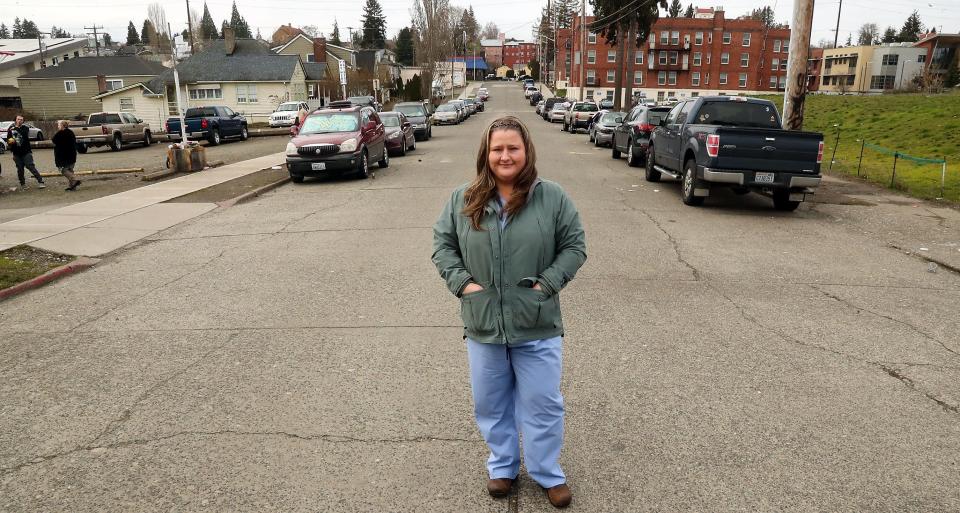'You could potentially save somebody’s life' – Narcan availability continues to grow

There is a scene that is all too familiar to Kimmy Siebens, a nurse and advocate who works regularly with Kitsap’s homeless population with the group Rock the Block. A yell that cuts through the quiet routine of life on the street: “He’s not breathing! He’s not breathing!” An overdose.
Someone goes for a stash of Narcan, the medication that can reverse an overdose from opioids like heroin or fentanyl and snatch a life back from the brink. The nasal spray will jet up into the person’s nose, and soon their chest will start to rise and fall again. Perhaps one or two more doses might be necessary.
Siebens carries the medication with her and is vocal about others doing the same: “I just knew as a nurse that seeing all of these thousands of blue (fentanyl) pills and seeing people dabble in it, even teenagers that were down there (in Bremerton), I knew that people were going to die if they didn’t have Narcan."
She continued: "There’s no easy way to get into substance abuse treatment without some significant help from people who are clear-minded and can coordinate transportation and signing up for wait lists or going to the hospital. The system is set up against particular people, and so I know to protect them until the system’s better – maybe, is my hope – that in the meantime there’s lives that need to be saved.”
The U.S. Food and Drug Administration approved the use of Narcan – the drug naloxone – without a prescription last year, and today it has become widely available. A survey of a handful of pharmacies across Kitsap County by the Kitsap Sun in recent days found the medication to be readily available for purchase. The People's Harm Reduction Alliance also has a program that allows people to order naloxone for free (phra.org/naloxone).
“I think Narcan is a crucial tool to have available right now to save lives in overdose situations,” said Dr. Gib Morrow, health officer with the Kitsap Public Health District. “The endgame as I see it is to make that drug obsolete and to keep people from going there in the first place.”
“I think all of us, as parents and educators and clinicians and public health professionals, really do need to be educating kids about the risks of fentanyl and counterfeit pills and getting that information out there about keeping people from going there in the first place and trying to identify what are those most effective evidence-based communications strategies that work to keep young folks and kids from using narcotics,” he added. “It’s really tragic to see what has been essentially a tripling of the overdose deaths in adolescents over the last 5-10 years.”

State statistics recording the number of opioid overdose deaths continue to show a steady upward climb in recent years: nearly 1,200 deaths were recorded statewide in 2020, about 1,600 were recorded in 2021, and about 2,000 were recorded in 2022. In Kitsap County, 57 opioid overdose deaths were reported in 2022, up from 35 in 2021 and 33 in 2020.
Local data reported by the Kitsap Public Health District has shown an uptick in instances in which Kitsap County emergency medical services responders have administered naloxone to a patient and seen an improved patient response. In 2020, 96 such cases were reported, in 2021, 111 cases were reported, in 2022, 132 cases were reported, and in data covering the first three quarters of 2023, 170 cases were reported.
Vince Hlavaty, medical services officer with the Bremerton Fire Department, said that prior to wider availability of naloxone in recent months, he was purchasing 20 syringes of the medication every week, and it was not uncommon for the department to administer 5-7 doses in a day. Now, with more of the medication available in the community, the department is averaging 2-3 doses per day, he said. Hlavaty estimated that responses are roughly an 80%-20% split between those who are homeless or underhoused and those who have more permanent homes.
Patients, he said, cross socioeconomic lines: "They come from all walks of life."
Hlavaty said he had heard through a contact recently of fentanyl pills going for 25 cents apiece: "It's ridiculous how affordable it is that you can buy it with pocket change," he said.
"It’s all over the place," said Bremerton Fire Department Assistant Chief John Payne. "It's unfortunately so affordable that it's easy to get a fix, and unfortunately your fix can kill you,"
Payne emphasized the risk-free nature of the medication itself: "One of the benefits of Narcan is that if you give it to someone who is unconscious for a reason other than opiate overdose, it's like water. There are no negative side effects. Someone can give it without fear that if it's not an overdose, it does nothing."
In a crowded gathering at Poulsbo City Hall earlier this month, the Kitsap Public Health District offered up some basic Narcan training, as Kaela Moontree, a healthy communities specialist with the health district, ran attendees through what to look for in an overdose, how to administer a dose of Narcan and then passed out a box of Narcan kits. As slides flicked across a screen at the front of the room, attendees raised their phones to snap pictures and record the information.
“Just given the climate today and the drug landscape, between where I park my car and where I go to work, I could come across someone who is overdosing,” Moontree said. “It literally is a life-saving drug. You’re saving someone’s life. Best reason. It’s rampant. Overdose rates continue to rise, and chances are that someone’s going to eventually, if they’re out and about, come across somebody who’s overdosed.”
Here's how the health district advises those responding to a potential overdose:
Call 911
Administer naloxone, if available
Administer rescue breaths if the person is not breathing
Stay with the person until help arrives or lay them on their side
According to the National Institute on Drug Abuse, signs of an overdose include:
Unconsciousness
Very small pupils
Slow or shallow breathing
Vomiting
Inability to speak
Faint heartbeat
Limp arms and legs
Pale skin
Purple lips and fingernails
The pitch for carrying Narcan from Siebens, the homeless advocate, is simple: “You could potentially save somebody’s life,” she said.
“We’ve had people whose lives we’ve saved and then they go on and become people that help other people,” she added. “It’s worth saving a life over something like this. In my mind, this is a medical situation, that just like if you did CPR on someone because they had a cardiac event, you bring them back to life, their life is meaningful and important. The person might be in the throes of intense substance use disorder, but it doesn’t mean they want to die.”
This article originally appeared on Kitsap Sun: Narcan becomes more widely available as overdoses continue to climb

